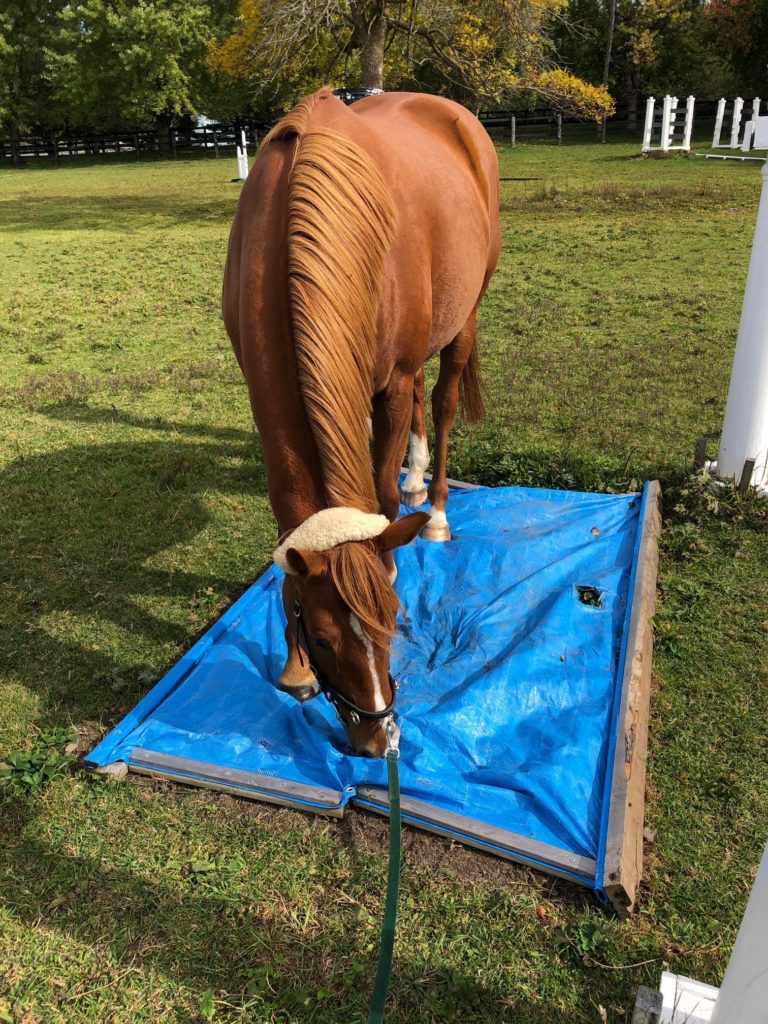Do equestrians know how their horses learn?
By Tanja Bornmann (MSc Equine Science, Academic Equitation)
Why is it so important for equestrians to become educated about learning theory and its practical application?
Because, knowingly or not, in each single encounter with horses we use learning theory tools from our training toolbox. Sometimes, equestrians pick the wrong tools from the toolbox, or do not know how to use the selected tool correctly and, due to this, horses may suffer (often silently) and become ‘naughty’, ‘unwilling’, ‘difficult’, or even dangerous to handle. Horses do not ‘test’ you, nor are they being ‘dominant’ and need you to tell them that you are the ‘boss’. Training is all about bringing the right message across in fair and meaningful dialogue between horse and trainer (yes, horses ‘talk’ to us using their ‘language’), employing the different tools that knowledge of learning theory will equip you with. Often, horses simply do not understand what the trainer wants from them, either because the trainer does not understand how to use cues correctly, or because he/she does not know how to reward ‘correct’ horse behaviour timely or predictably so that the desired learning outcomes can be achieved.

Traditionally, horse training has been based on negative reinforcement [1] as the mounted rider communicates with the horse via the ‘rider aids’, which, in traditional training, are solely based on negative reinforcement [2]. Hence, it is very important that all horse handlers and riders understand what negative (and positive – more about this later) reinforcement means, how it can be practically applied, and that its incorrect application can result in a compromised welfare state and, potentially, abuse [3].
We can observe horse abuse in all equestrian disciplines, some types of abuse are just more obvious to spot than others. Unfortunately, unlike some other mammals such as dogs, horses very rarely use their voices to indicate that they are in pain. Horses’ reactions to pain or discomfort are often subtle and hard to spot since equids, based on their natural survival instinct, tend not to express pain too openly. You may have witnessed some riders applying strong leg or even spur pressure, the ‘go signal, and rein pressure, the ‘slow down’ signal, at the same time until the horse ‘complies’, i.e. does what the rider wants. This can present a welfare concern due to the simultaneous use of two contradictory cues – accelerating and decelerating aids – and may cause discomfort or pain. Some horses may try to escape pain by bucking or rearing, often accompanied with frequent tail swishing and facial expressions indicating pain. Other horses may simply ‘surrender’ to the pain and eventually enter a state of learned helplessness [4] where they have learned that any attempt to escape a pain- or stressful situation is not successful. Horses that have entered a state of learned helplessness simply give up trying and may become depressed, which can sometimes be observed in horses termed ‘bomb-proof’ or in some school horses.
Some riders may constantly apply leg pressure to their horses’ flanks even if the horse already moves forward or maintains the speed/rhythm (i.e. incorrect understanding of negative reinforcement: no leg pressure release when the horse responds with ‘forward’). In this example, horses can become habituated to the constant leg pressure and the rider may need to apply even stronger leg pressure to ask for an increase in speed/lengthening of strides in the future. Horses that have habituated to leg pressure are often falsely termed ‘lazy’ and their riders may choose to use spurs or whips in the future, punishing the horse for his rider’s incorrect understanding of learning theory.
What is learning?
Learning means behaviour modification and our behaviour can be influenced by interactions with the environment, including other humans and animals. When training horses to perform for us as riding, driving, or working partners, we can modify their behaviour by applying the principles of learning theory. Through habituation and (de-)sensitisation, as well as operant and classical conditioning (also known as Pavlovian conditioning), horses can be trained to become reliable and safe companions. Operant conditioning, also known as instrumental conditioning, is linked to cue (stimulus) – response (‘right’ or ‘wrong’ behaviour) – consequence (reward or punishment) relationships [5].
We can reward (i.e. reinforce) wanted/desired horse behaviours by giving horses (i.e. adding, +) something pleasant or desirable, such as food, scratches, turnout. These reinforcers are termed primary positive reinforcers and the process is called positive (+) reinforcement. Primary means that the reinforcers are natural to the horse, in contrast to secondary (i.e. learned) positive reinforcers such as pats on the neck, the sound of a clicker, which a horse needs to associate or link to a primary positive reinforcer first in order for the secondary positive reinforcer to become meaningful and positive. We can also reward horses by removing (i.e. subtracting, -) a stimulus that they perceive unpleasant, e.g. leg or rein pressure, once they have shown a correct or desired response, i.e. we immediately remove the leg pressure when the horse yields. This is termed negative (-) reinforcement. Contrarily, we can apply punishment to stop horses from showing behaviours we deem ‘bad’ or unwanted/undesired [6]. Punishment can also be subdivided into positive punishment, i.e. adding something unpleasant such as pressure/pain, or negative punishment, i.e. removing or withholding something pleasant such as food, which one should never do of course as it would compromise horse welfare.
What do equestrians know about learning theory?
A study investigating riders’ perceptions and understanding of learning theory, conducted as part of a MSc dissertation project and involving 1028 participants, revealed gaps in equestrians’ theoretical knowledge of the terminology – positive and negative reinforcement and punishment – when participants were asked to select the correct definitions or provide practical examples [7]. 85.4% of all survey participants believed that positive reinforcement was the most successful horse training method. In contrast, 82.5% of all participating equestrians thought that ‘releasing the aid/pressure’, which constitutes negative reinforcement, would be the most effective reward, and those participants considerably more often selected the incorrect definition of negative reinforcement. When the participating riders were asked whether knew how their horses learn certain behaviours, 95.8% responded with ‘yes, but only 25.9% provided a correct or partly correct example of negative reinforcement and 20.8% confused negative reinforcement with punishment, possibly due to respondents’ lacking knowledge of the terminology [8].
Why is this the case? Equestrians may receive misleading or incorrect information via their coaches as significantly more study participants, who indicated that the licensed/qualified coach would be their main knowledge source for training knowledge, selected the wrong definition of negative reinforcement. This is not surprising, given that some professional equestrian coaches [9,10] and veterinarians [11] may lack a clear understanding of the principles of learning theory and, therefore, the correct application of learning theory by some amateur equestrians could be questioned.
Today, learning theory and horse behaviour still do not present an integral part of some national equestrian federation’s/governing body’s coaches’ training syllabi. Yet, research findings stress the need for implementing learning theory in equestrian coach training and suggest that equestrians’ competence in correctly applying learning theory could be questioned. However, it seems that, even if some equestrians may not comprehensively understand the impact of negative reinforcement on horse behaviour, pressure release was of high importance to the participants of the MSc dissertation study mentioned above. It appears that, to some extent, equestrians are aware about the negative impact of constant pressure (i.e. non-release of pressure after a desired behaviour has been shown) in training on horse behaviour, which is encouraging in terms of horse welfare.
References:
[1] Heleski, C., Bauson, L. and Bello, N., 2008. Evaluating the Addition of Positive Reinforcement for Learning a Frightening Task: A Pilot Study With Horses. J Appl Anim Welf Sci, 11, 213-222.
[2] McLean, A.N. and McGreevy, P.D., 2007. Ethical equitation: Capping the price horses pay for human glory. J Vet Behav, 5, 203-209.
[3] Preshaw, L., Kirton, R. and Randle, H., 2017. Application of learning theory in horse rescues in England and Wales. Appl Anim Behav Sci 190, 82–89.
[4] Overmier, J.B. and Seligman, M.E.P., 1967. Effects of inescapable shock on subsequent escape and avoidance learning. J Comp Psychol 63, 28-33.
[5] Skinner, B.F., 1953. Science and Human Behaviour. New York, The Free Press.
[6] Mills, D.S., 1998. Applying learning theory to the management of the horse: the difference between getting it right and getting it wrong, Equine Vet J Supplement: Equine Clinical Behaviour, 27, 44-48.
[7] Bornmann, T., 2016. Riders’ perceptions, understanding, and theoretical application of learning theory in horse training, Proceedings of the International Society for Equitation Science Conference. Saumur, France 23-25 June. Saumur, France: International Society for Equitation Science and French Institute for Horses and Riding, Saumur (2016).
[8] Telatin, A., Baragli, P., Green, B., Gardner, O., Bienas, A., 2016. Abstract only Testing theoretical and empirical knowledge of learning theory by surveying equestrian riders. J Vet Behav: Clinical Applications and Research Vol 15 p.79.
[9] Warren-Smith, A.K. and McGreevy, P.D., 2008. Equestrian Coaches’ Understanding and Application of Learning Theory in Horse Training. Anthrozoös, 21(2), 153-162.
[10] Wentworth-Stanley, C., Randle, H. and Wolframm, I., 2014. Survey of Canadian Certified Coaches’ Understanding and Application of Learning Theory in Horse Training, Proceedings of the International Society for Equitation Science Conference. Vingsted, Denmark 7-9 August. Tjele, Denmark: Danish Center for Food and Agriculture and Arhus University, Vingsted (2014).
[11] Doherty, O., McGreevy, P.D., Pearson, E., 2017. The importance of learning theory and equitation science to the veterinarian. J Appl Anim Behav Sci, Vol. 190, 111-122.

